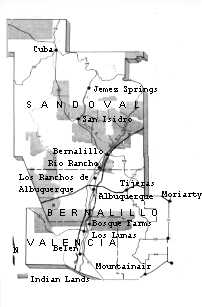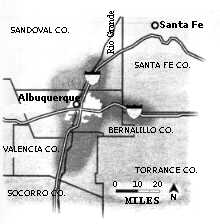 Albuquerque's Environmental Story
Albuquerque's Environmental Story
Educating For a Sustainable Community
Environmental Topic: Regionalism
by Dennis Foltz and Stephen Burstein
Background
Albuquerque, with a population of 410,000 and an employment of over 260,000,
has a metropolitan area or regional population of 658,000 people and an employment
of 293,000. Many of these people live in Bernalillo County, but many others
live in Sandoval, Torrance, Valencia, and southern Santa Fe Counties. These
people share a common job base, transportation system, and housing supply, to
name a few. They also enjoy the amenities that Albuquerque provides. The Sandia
and Manzano Mountains separate watersheds and "airsheds" between the Estancia
Basin and the Rio Grande Valley.
Albuquerque Region 1990 Socio-Economic Summary and 2015 Forecasts
|
| 1990
| 2015
|
| Total Population
| 599,416
| 819,062
|
| Total Households
| 225,289
| 323,820
|
| Total Housing Units
| 246,561
| 351,529
|
| Single-Family Units
| 186,794
| 272,462
|
| Multifamily Units
| 59,767
| 79,067
|
| Total Vehicles
| 412,621
| 592,246
|
View of the Region
From the air, it is impossible to tell where each community or county begins
and ends. Rather, the patterns of development appear as one continuous urban
area that extends from the town of Bernalillo on the north to Belen on the south
and from the escarpment on the west to Moriarty on the east.
Several observations can be made from the air:
- Housing consists of mostly low-density, single-family homes.
- Transportation is almost totally composed of automobiles; there are very
few buses, bicycles, or people walking.
- Work and shopping areas are set off by themselves, not "mixed-in" with residential
areas.
- Except for the foothills of the Sandias and the bosque along the Rio Grande,
open spaces are not linked together; however, arroyos form a secondary set
of open space "arteries" into the urbanized area.
- On many mornings, particularly in the winter, air pollution occurs, especially
in the Rio Grande basin portion of the region.
The Region's Systems
The living patterns of the people in Albuquerque's region create a need for
region-wide systems to serve the people. Examples of these systems are
transportation, water and sewerage, open space and recreation, education, and
housing.
Systems requirements differ as living patterns vary. Thus the current, low-density,
scattered pattern depends almost totally on the automobile. A more compact pattern
that would emphasize higher densities and mixed uses might be more conducive
to transit, walking, and other transportation modes.
Systems required by differing living patterns also vary in cost. The current
low-density, scattered pattern requires more miles of roads and water/ sewer
lines than compact patterns. This low-density pattern not only costs more because
of the length of the required systems, but also requires that families own and
maintain multiple vehicles. Thus the cost of doing business rises, and the Albuquerque
region finds itself in a less competitive position in the global economy we
now live in.
 Governments
in the Region
Governments
in the Region
Within the entire region are four counties, seventeen municipalities and nine
Indian tribal governments.
The contiguous urbanized area contains seven cities and towns, of which Albuquerque
and Rio Rancho, spread over three counties, are the largest.
In order for regional systems to be planned and managed, people from multiple
jurisdictions must work together. Issues that had once appeared to be the problems
of a single town, city, or county must be considered by planners and politicians
as regional issues in which we all have a stake.
The coordination of transportation and land-use plans across the entire region
can result in an overall, coherent urban form resulting in clean air, water
conservation, open space preservation, and economic development. The long-term
sustainability of the special natural and man-made qualities of the Albuquerque
region requires a unified regional strategy.
The Region's Future
AS THE CITY SPREADS
 |
What will the future be like in Albuquerque's region? Will we continue the
low-density, scattered development pattern prevalent today or will we find other,
more compact patterns that support other transportation modes, conserve water,
maintain and link open space and emphasize mixed uses of work, home, and shop
and emphasize mixed uses of work, home, and shopping?
Don't be decieved by the political boundaries of Albuquerque - Rio Rancho includes
more square miles. The city's social, cultural, economic and political influence
travels well beyond its limits, spreading into Valencia, Cibola, Sandoval, Santa
Fe, Torrance and, of course, Bernalillo counties. Albuquerque, in fact, is much
more than a city. It is a region. But it is only beginning to think regionally.
Map by Jeff Neumann
Options and Opinions
Discussion Questions
- What issues might be considered truly regional?
- Does air pollution in Rio Rancho affects air quality in Albuquerque? Does
air pollution in Albuquerque affects air quality in Belen?
- Should a linked open space system be created that defines the edges of
each community in the region? How would such a system affect where people
shop or work, recreational opportunities, community identity, proximity to
natural areas, and use of cars, bicycle, or public transit?
- What are the impacts (both positive and negative) of a new business center
or a shopping center locating in a community or neighborhood?
- What are ways to get people to talk about region issues? Who should be
involved?
- Why might some communities in the Albuquerque region be reluctant to join
in a more formal regional political structure?
- What are ways to get people to talk about regional issues? Who should be
involved?
Possible Solutions/Opinions
- Since air, water, and the natural environment in open space don't have
political boundaries, it is necessary to deal with them regionally.
- A Regional Transit Authority must be established for many reasons.
- All the counties in the Albuquerque region should be required to have comprehensive
plans.
- All communities in the Albuquerque region should have mandatory vehicle
emissions inspection.
- One reason some smaller communities near Albuquerque are skeptical about
regionalism is that they are afraid of losing some of their authority.
Activities
- Contact the Middle Rio Grande Council of Governments (MRGCOG, 247-1750)
to find out what counties are considered part of the metropolitan Albuquerque
region. On the outline map of New Mexico below, color and label these counties.
Set up a chart showing the geographic size and population of each of those
counties. What is the population of the total region? What is Albuquerque's
population? Bernalillo County's? Find out from MRCOG how many people from
outside Albuquerque work in the city? In what other ways do people from the
region interact with Albuquerque?
- Conduct a panel discussion about the issues facing the metropolitan Albuquerque
area and the possibility of a more regional approach to them in the near future.
Topics for the discussion might include the following:
- What cities and counties are considered part of the metropolitan region
and why?
- Is there a need for a regional transportation system, and if so, what
kind?
- Is air quality an Albuquerque issue or a regional one?
- What are the pros and cons of a unified approach to regional issues?
Poll the panel audience before and after the discussion to learn about
their attitudes toward regionalism.
- Find out about metro areas in other parts of the country, e.g., Portland,
Oregon, Miami/Dade County, Florida, Indianapolis, Indiana. Use the Internet
or the library to do research. Consider such questions as the extent and size
of the metro region; the type of political organization; the factors that
bind the large city and its surrounding communities together; the type of
transportation system(s); how long the metro region organization has been
in existence; how satisfied the general public and the various member communities
are with the regional approach. Discuss how the Albuquerque metro region compares
with these others.
- Conduct a survey to find out what people know about the relationship between
Albuquerque and the metropolitan area, and what their attitudes are about
a regional approach to some major issues. Develop a brief questionnaire to
learn:
- Whether people have ever considered this question before;
- What cities/counties they consider part of Albuquerque's metro region;
- What issues they think could be considered "regional"; and
- What their attitudes are about a unified approach to these issues.
- Survey parents, siblings of voting age, relatives, friends. Analyze the results
of the poll. Invite a planner from MRGCOG to come to the class to discuss
the findings.
(Up to Section V, Back to Recreation,
On to Safety)
Copyright © 2008, Friends of Albuquerque's Environmental Story
 Governments
in the Region
Governments
in the Region